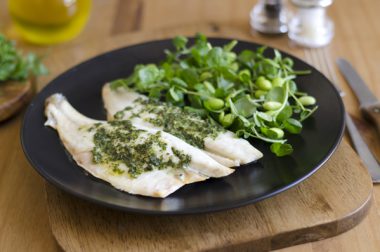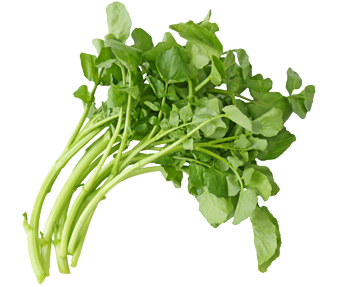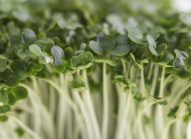Recipes we love
See all recipesWatercress sauce
This sauce is perfect with white meat, fish, cold meat… It is very quick and easy to prepare. Prepar...
Rolled ham with watercress and watermelon
A fresh and light recipe, perfect for summer evenings. Eat as much as you like; will bring you the v...
Health
benefits
It’s rich in provitamin A
Watercress is rich in beta-carotene, or provitamin A, which is converted to vitamin A in the body. This vitamin is important for vision, iron metabolism, the immune system, and healthy skin.
Watercress is also:
- A source of vitamin B9 (cell renewal, which is very important for pregnant women for the development of the fetus, growing children, and people recovering from illness).
- A source of vitamin C (the immune system, collagen formation, energy, the nervous system, fatigue, iron absorption)
- A source of calcium (healthy bones, muscle contraction, blood coagulation, energy). It is very easy to digest.
- A source of iron (cognitive function, red blood cells, the immune system, energy, lowers fatigue)
Watercress also contains:
- Glucosinolates
- Zinc
- Magnesium
- Antioxidants: Zeaxanthin, lutein, and flavonoids
Nutritional
composition
When is the right time to eat it?
During cold seasons.
Watercress is available from September to May.
Vegetable patch
or urban balcony?
Watercress is an herbaceous plant that grows well in humus-rich, drained, pH-neutral (pH=7) soil, in a partially shaded position.
To learn everything you need to know about growing watercress, read the page on growing advice.
Choosing
and storing
Choosing the best watercress:
- Leaves should be firm, intact, and vibrant in color.
- The bunch of leaves should all be similar and shouldn’t contain leaves from other plants
Storing watercress:
- Watercress is fragile and should be eaten shortly after being picked.
- In the refrigerator: One or two days in packaging in the vegetable drawer.
Tips
and tricks
How to prepare watercress:
The glucosinolates quickly disappear into the cooking water, so it’s better to eat watercress raw or lightly cooked, gently dropped into the smallest amount of water possible.
Cooking instructions:
- 10 mins: Steamer or pressure cooker
- 20 mins: In boiling water
- 3 à 4 mins: Battered and deep fried
Watercress goes well with:
Raw: watercress is the main ingredient in delicious salads, served with apples, walnuts, and fragrant vinegar.
Cooked: watercress can also be enjoyed in sauces, soups, thick soups, or in purées.
It goes very well with fish served as a coulis. It also goes excellently with goats’ cheese and can be deep fried.
Can everyone eat it?

Young children
It can be eaten from the age of six months in purées with potatoes to soften its strong taste.
And everyone else
Watercress is suitable for all ages, except for those with kidney stones or who are at risk of kidney stones. This is because watercress contains a lot of oxalates, compounds that can cause stones to form. For this reason, it’s important not to eat too much watercress, or ask a health professional for advice.
See plenty of other tips for encouraging children to eat vegetables
Where does it come from?
Origins and varieties
Origins
Watercress is mostly grown in the UK, Germany, and France.
Watercress is an herbaceous plant grown for its edible, bitter leaves.
It was first grown in the 18th century and cultivation methods have not changed much since this time. All picking and tending is still done entirely by hand.
Varieties
It grows with its roots in water in a watercress bed exclusively supplied with spring water. The leaves that grow in the water are picked and eaten.



 Eggplant
Eggplant  Tomato
Tomato  Vegetable garden: growing white beans
Vegetable garden: growing white beans 










